English
Click to download: English National Curriculum | English Vision and Intent Statement
At Willoughby Primary School, we believe that teaching English is at the heart of every child’s education. Learning to read, write and communicate with confidence opens doors to imagination, understanding, and endless possibilities. From the very start of their school journey, children at our school are encouraged to explore language, share their ideas and find their own voice. Through high-quality English teaching, we aim to empower every child to become a thoughtful communicator, an enthusiastic reader and a skilled writer who can engage with the world around them.
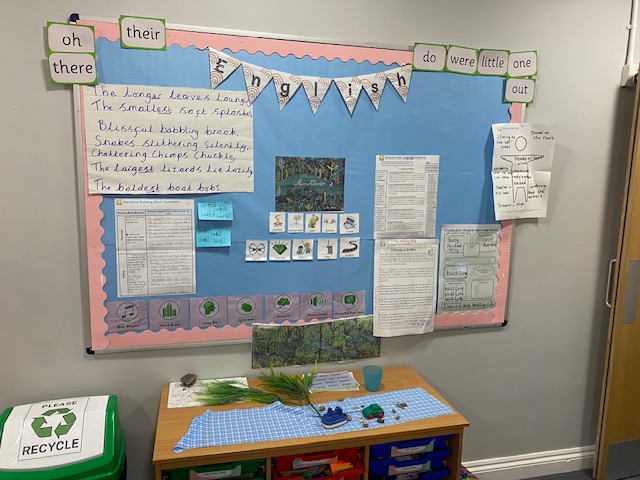
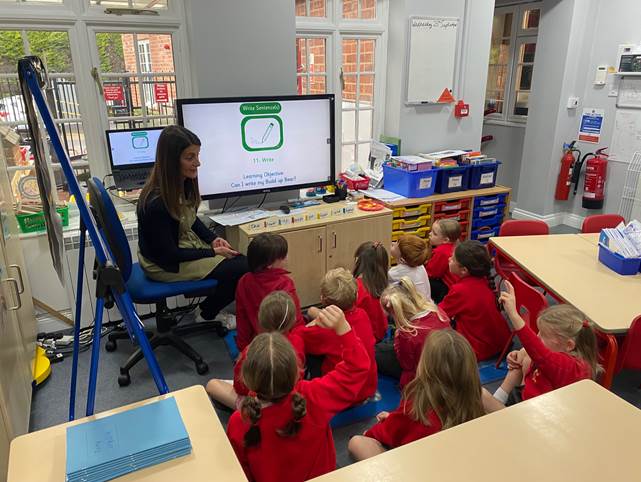
Phonics
Our phonics curriculum is carefully designed to provide a broad and balanced education that meets the needs of all children, supporting them to read, write and communicate with confidence.
We follow the award-winning ‘Ready Steady Phonics’ programme by Literacy Counts — a DfE-validated systematic synthetic phonics (SSP) programme. It is research-informed, impact-proven and designed to ensure every child becomes a fluent and confident reader. The programme includes clear progression and detailed guidance for effective teaching, along with fully decodable texts that match each child’s growing phonics knowledge.
In EYFS, children are taught phonics daily through a structured four-part lesson that builds knowledge and understanding step by step. They continue with this programme throughout Key Stage 1.
Children are encouraged to apply their phonics skills in both reading and writing, supported by matched decodable texts available in print and online. Those who need extra help take part in Ready Steady Go intervention sessions, ensuring that every child makes progress.
Each phonics lesson follows a familiar routine to reduce cognitive load and help children feel confident and successful. During lessons, children:
- Practise oral blending (e.g. c/oa/t) and segmenting skills.
- Learn new graphemes and apply them in words and sentences.
- Have regular opportunities to write using their new knowledge.
- Use “pure sounds” when decoding words (avoiding adding ‘uh’ to sounds).
Please watch these sound pronunciation videos for guidance.
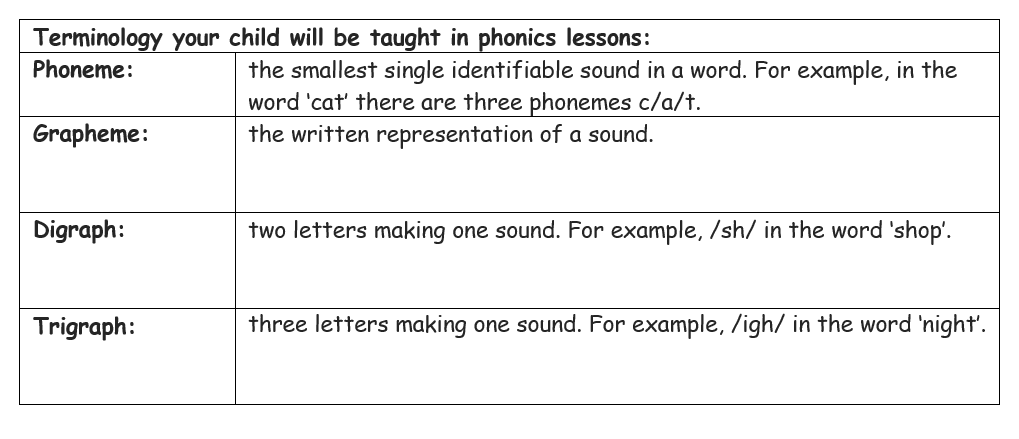
Children take home a carefully matched phonics reading book that is 90–95% decodable for them. We ask that they read this book with an adult at home at least four times each week. Regular practice helps to build fluency, accuracy and expression, giving children the confidence to become independent readers.
Additionally, children will also bring home a sharing book each week. This is a book chosen by the child for them to enjoy with others. The children are not expected to read this book independently — instead, it’s an opportunity for someone to read to them, talk about the story, discuss the pictures, and explore new vocabulary. Sharing stories in this way helps foster a love of reading and builds important language and comprehension skills.
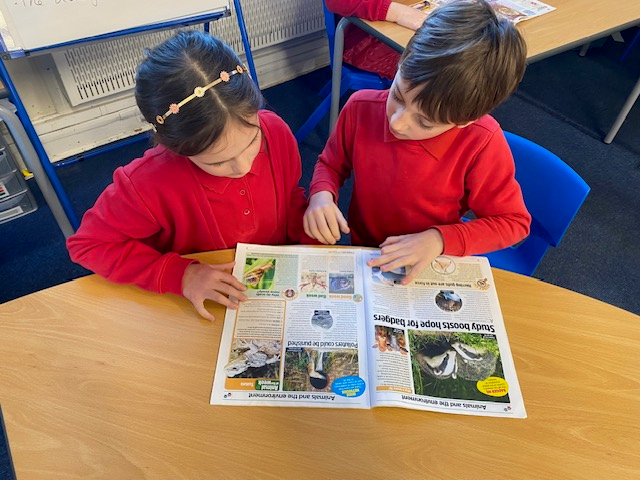
Spellings
Year 3-4 Autumn 2 | Week 7 – Week 8 – Week 9 – Week 10 – Week 11
Year 3-4 Spring 1 | Week 13 – Week 14 – Week 15 – Week 16
Year 3-4 Spring 2 | Week 18 – Week 19 – Week 20 – Week 21
Year 5 | 14th November – 21st November – 28th November – 5th December – 12th December
Year 5 Spring 1 | 16th January – 23rd January – 30th January – 6th February
Year 6 | 14th November – 21st November – 28th November – 5th December – 12th December
Year 6 Spring 1 | 16th January – 23rd January – 30th January – 6th February
Spelling
Our aim is for every child at Willoughby to become a confident, accurate speller who can use their skills independently across the curriculum. By embedding spelling strategies through consistent teaching, revision and support, we equip children with the tools they need to write with accuracy and clarity.
We follow ‘Ready Steady Spell’ by Literacy Counts This systematic programme ensures children develop the essential skills and strategies needed to spell confidently and accurately. The scheme is progressive, covering Years 2 to 6, and fully meets National Curriculum expectations.
Spelling is taught in a clear and methodical way, with consistent teaching routines, regular review and interactive activities that help move spelling knowledge into long-term memory. The teaching follows a three-stage cycle for each spelling objective:
- Introduce: children meet the new spelling rule or strategy for the first time.
- Reinforce: they revisit the objective to practise and consolidate their understanding.
- Embed: children apply the rule or strategy confidently in their writing, ensuring it becomes part of their long-term memory.
This approach allows for repeated practice across lessons and year groups, supporting children to overlearn key rules and strategies. At the start of Year 2, spelling lessons also incorporate Year 1 National Curriculum spelling rules not covered through phonics teaching.
There are seven different strategies taught in the Ready Steady Spell programme:

At Willoughby, year 3 and 4 children are taught spelling within a two-year rolling programme which is outlined in the table below. However, due to SATS preparation and timetabling, year 2, 5 and 6 children are taught spelling as individual year groups.

To support learning at home, children will bring home a spelling booklet which allows them to practise spelling objectives in a structured way, reinforcing classroom learning and giving parents clear guidance on how to help. Spellings will be tested the week after they have been taught in class.
Please refer to the following documents for further information on the seven strategies used and ways you can support your child at home.
Reading
We believe that reading is the key to learning and a lifelong love of knowledge. Our reading curriculum is designed to help every child become a confident, fluent, and enthusiastic reader, who is able to understand and enjoy texts across all areas of the curriculum. We aim to develop readers who can not only decode words but also comprehend meaning, think critically, and develop a genuine love of books.
Alongside systematic phonics teaching in EYFS and Class 1, children take part in small guided reading sessions. These groups are organised according to each child’s ability and are continually monitored and adapted to meet their individual needs.
In Year 2, these guided reading sessions evolve into fluency-focused sessions, helping children to read more smoothly, accurately and with expression, further supporting their comprehension and confidence as readers.
As the children move into KS2, we follow a research-informed approach, incorporating Christopher Such’s reading structure. Each week, we create a balanced and purposeful experience bringing reading to life in the classroom.
Our approach focuses on three key elements:
1. Close Reading
- Encourages children to engage deeply with texts.
- Develops critical thinking, comprehension, and analytical skills.
2. Fluency Practice
- Supports children to read smoothly, accurately, and with expression.
- Allows repeated reading of texts.
- Helps children improve reading speed, confidence, and understanding.
3. Extended Reading
- Exposes children to a rich and diverse range of texts.
- Encourages exploration of different genres, authors, and topics.
We also place great emphasis on language development and reading for pleasure across the curriculum. At the end of Year 2 and throughout KS2, we encourage children to independently select their own reading books from our inspiring library which is filled with new and engaging books. To further encourage a love of reading, we have the Nottinghamshire mobile library visiting our school every 4 weeks and we hold Scholastic book fairs throughout the year, giving pupils the opportunity to browse and purchase new books at a low price. We want every child to see themselves as a reader — someone who reads not just to learn but for joy, curiosity and imagination.
Writing
Our aim is for every child to leave our school as an enthusiastic, fluent writer who takes pride in their work and is ready for the next stage of their education. Through inspiring literature, purposeful writing opportunities and a love of language, our pupils learn that their words have power.
We follow ‘Ready Steady Write’ by Literacy Counts – a programme that places high-quality, vocabulary-rich literature at the heart of writing. This carefully sequenced curriculum ensures that all children master the key skills of writing and learn to write for a clear audience and purpose.
Ready Steady Write follows a four-step teaching sequence of Immerse – Analyse – Plan – Write (in EYFS, this sequence is called Jump in – Look – Plan sentences – Write sentences but follows the same principles):
- Immerse: Children explore engaging, high-quality texts and experience rich language in context.
- Analyse: They study how authors use language, structure, and style to create meaning.
- Plan: Children plan their own writing, drawing inspiration and vocabulary from model texts.
- Write: They craft, edit, and improve their work, developing pride and precision in their writing.
We use a range of proven strategies, including modelled and shared writing, sentence accuracy and guided editing, to help children develop confidence and skill at every stage. Spoken language is central to our approach; through discussion, drama, and vocabulary exploration, children learn how to organise and express their ideas before writing them down.
Our writing curriculum is both ambitious and inclusive, ensuring every child – regardless of background or need – can achieve success. Units are carefully mapped and sequenced to meet the needs of our mixed-age classes, ensuring full coverage of the statutory curriculum. Wherever possible, we make meaningful links across the wider curriculum, so children see how writing connects to other areas of learning.
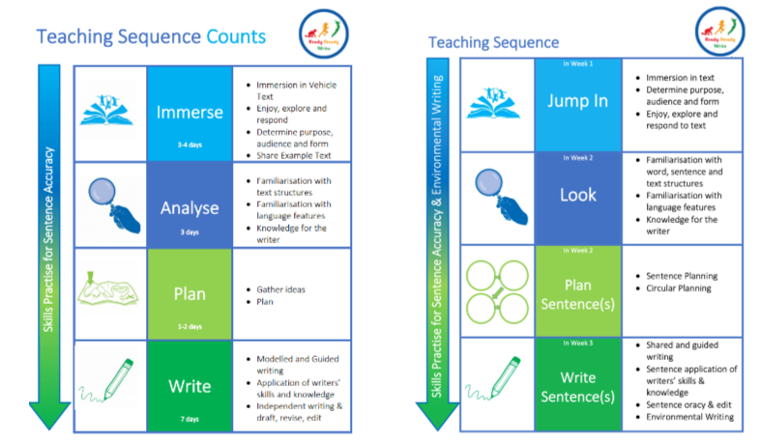
At Willoughby Primary School, we believe that clear, neat handwriting is a vital skill that enables children to communicate effectively and take pride in their written work. Our handwriting curriculum is designed to meet the requirements of the National Curriculum and to help every child become a fluent and legible writer.
In EYFS, teaching is aligned with the Ready Steady Phonics handwriting script and rhymes are used to learn correct letter formation. To prepare for writing, they take part in a daily fine-motor skills session to strengthen whole-body, hand and finger muscles. Children are introduced to correct pencil grips, sitting positions and paper placement from an early age. These sessions help children develop control, build pencil pressure and gain confidence in mark-making and early letter formation, ready for more formal writing as they move through school.
From Year 1 we use the Morrells Handwriting Technique, which provides a structured and engaging approach to handwriting. This technique builds confidence, fine motor control and consistency, helping children to form letters correctly before progressing to joined writing. Short sessions are taught frequently throughout the week, giving children plenty of opportunity for regular practice under the guidance of an adult.
Through this approach, children:
- Practise and maintain a correct pencil grip.
- Are taught the correct start and exit points for each letter — without the use of ‘lead-in’ strokes from the line.
- Learn to form letters accurately and neatly before being introduced to joined-up handwriting, which is taught only when children are ready.
Key Information
Head Teacher: Mrs Joanne Linnett
Co-Chairs of governors: Mrs Rebecca Kealy & Mr Nicholas Brown
Type of School: County Primary Co-Educational Day School for 4-11 years
Contact Details
Please address all queries to our Office Manager Mrs Laura Shepherd
Address: Willoughby Primary School, Church Lane, Willoughby on the Wolds, LE126SS
Useful Links
Willoughby Primary School on the Ofsted website & the Parent View
Willoughby Primary School on the Dept. For Education website
Admissions: Standard reception criteria from Nottinghamshire CC
